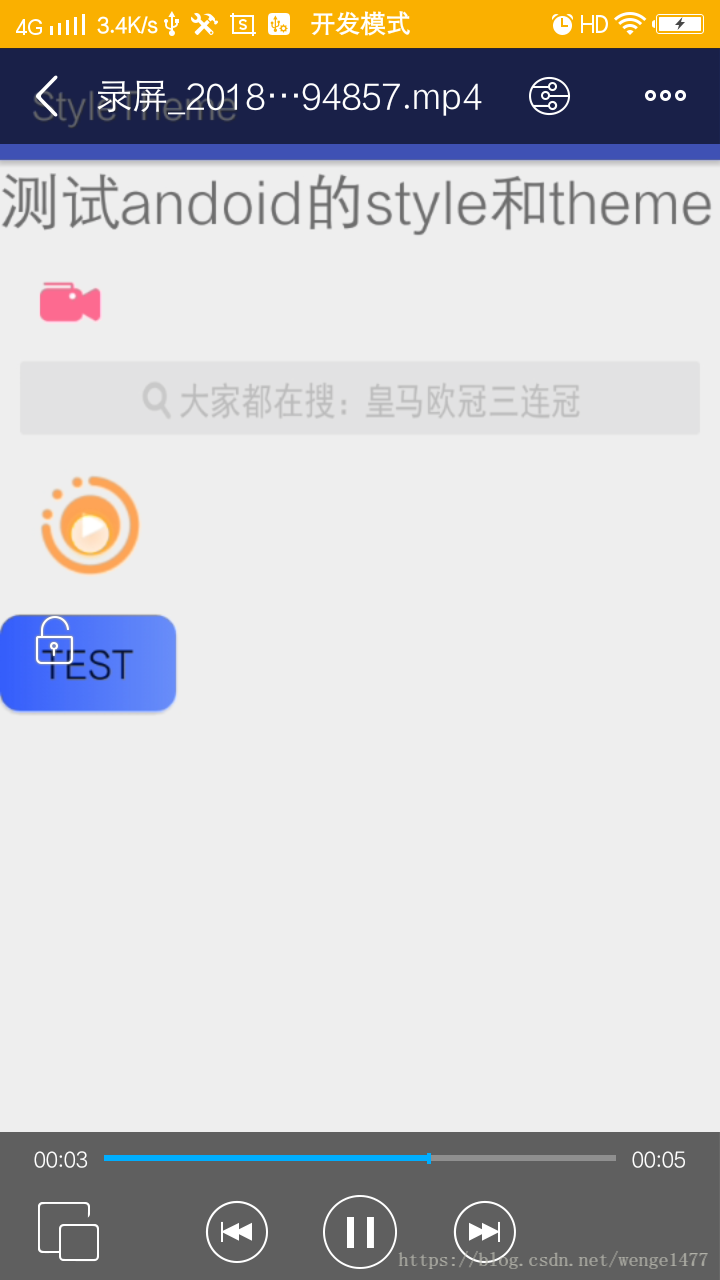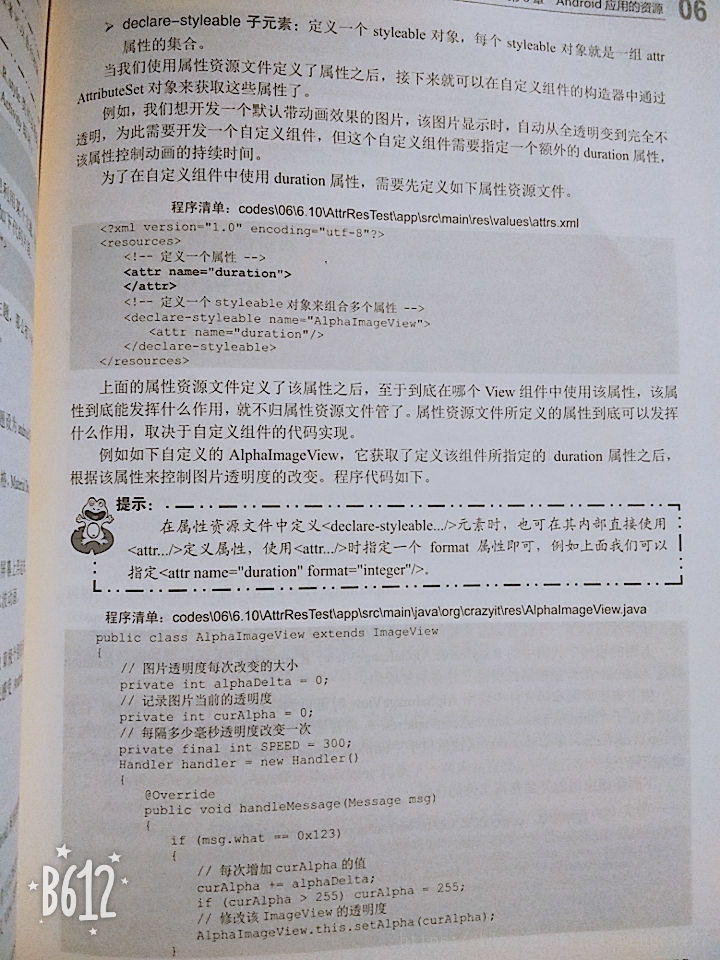一、Layout资源时放在/res/layout/目录下面,layout资源下面的根元素通常为布局管理器,在每个布局管理器中定义各种的view.
二、使用菜单menu资源,资源时放在/res/menu/目录下面,资源的根元素通常为<menu ...../>元素,其中menu的用法在,另一片有介绍menu的一些用法
三、样式Style,该资源存放在/res/values/目录下面,样式资源的根元素通常为<resources......./>,该元素中可以包含多个<style....../>子元素,每一个<style.../>定义一个样式。
<style...../>元素指定如下的两个属性。
name:样式的名称
parent:样式继承父样式,该样式继承父样式的全部定义,也可以覆盖父样式的指定格式
<style...../>包含多个<item..../>子元素。
如下:
<resources>
<!-- Base application theme. -->
<style name="AppTheme" parent="Theme.AppCompat.Light.DarkActionBar">
<!-- Customize your theme here. -->
<item name="colorPrimary">@color/colorPrimary</item>
<item name="colorPrimaryDark">@color/colorPrimaryDark</item>
<item name="colorAccent">@color/colorAccent</item>
</style>
<style name="DefaultFontStyle">
<item name="android:textSize">29sp</item>
<item name="android:textColor">#101010</item>
</style>
<style name="DefaultBackgroud" parent="DefaultFontStyle">
<item name="android:background">#3cf968</item>
</style>
<style name="DefaultStyle" parent="@style/DefaultBackgroud">
</style>
<style name="TextViewFontStyle">
<item name="android:textSize">30sp</item>
</style>
<style name="ButtonDefault">
<item name="android:background">@drawable/pzb</item>
<item name="android:focusable">true</item>
<item name="android:clickable">true</item>
<item name="android:layout_margin">20dp</item>
</style>
<style name="EditTextDefault">
<item name="android:background">@drawable/ps</item>
<item name="android:textColor">#ec7272</item>
<item name="android:layout_marginLeft">10dp</item>
<item name="android:layout_marginRight">10dp</item>
</style>
<style name="ButtonChange">
<item name="android:background">@drawable/button_selector</item>
<item name="android:layout_margin">20dp</item>
</style>
<style name="Button_gradient">
<item name="android:textSize">20sp</item>
<item name="android:background">@drawable/button_selector_gradient</item>
</style>
</resources>
在布局文件中可已使用
<?xml version="1.0" encoding="utf-8"?>
<LinearLayout
xmlns:android="http://schemas.android.com/apk/res/android"
xmlns:app="http://schemas.android.com/apk/res-auto"
xmlns:tools="http://schemas.android.com/tools"
android:layout_width="match_parent"
android:layout_height="match_parent"
android:orientation="vertical"
tools:context="com.example.asus.styletheme.MainActivity">
<TextView
android:layout_width="match_parent"
android:layout_height="wrap_content"
android:text="测试andoid的style和theme"
android:id="@+id/test_style"
style="@style/TextViewFontStyle"/>
<Button
android:layout_width="30dp"
android:layout_height="20dp"
android:id="@+id/pz"
style="@style/ButtonDefault"/>
<EditText
android:layout_width="match_parent"
android:layout_height="37dp"
android:id="@+id/edit_test"
style="@style/EditTextDefault"/>
<Button
android:layout_width="50dp"
android:layout_height="50dp"
style="@style/ButtonChange"
android:id="@+id/button_test"/>
<Button
android:layout_width="wrap_content"
android:layout_height="wrap_content"
android:id="@+id/button_gradient"
android:text="test"
style="@style/Button_gradient"/>
</LinearLayout>
效果图

四、主题资源使用,主题资源通常也放在/res/values/目录下面,主题资源的xml文件同样也是以<resource..../>作为根元素,同样也是使用<style..../>元素来定义主题样式。
主题和样式的区别:
1、主题不能作用于单个的view组件上面,主题应该是对整个应用中的所有activity起作用,或者对指定的activity起作用。
2、主题定义的格式应该是改变外观的格式,比如:窗口标题,窗口边框
如:
<resources>
<!-- Base application theme. -->
<style name="AppTheme" parent="Theme.AppCompat.Light.DarkActionBar">
<!-- Customize your theme here. -->
<item name="colorPrimary">@color/colorPrimary</item>
<item name="colorPrimaryDark">@color/colorPrimaryDark</item>
<item name="colorAccent">@color/colorAccent</item>
</style>
</resources>
使用:
<application
android:allowBackup="true"
android:icon="@mipmap/ic_launcher"
android:label="@string/app_name"
android:roundIcon="@mipmap/ic_launcher_round"
android:supportsRtl="true"
android:theme="@style/AppTheme">
<service android:name=".service.MyService"></service>
<service android:name=".service.MyService1"></service>
<service android:name=".service.ChangeService"></service>
<receiver android:name=".SmsReceiver.SmsReceiver">
<intent-filter><action android:name="android.provider.Telephony.SMS_RECEIVED"/>
</intent-filter>
</receiver>
<activity android:name=".MainActivity">
<intent-filter>
<action android:name="android.intent.action.MAIN" />
<category android:name="android.intent.category.LAUNCHER" />
</intent-filter>
</activity>
</application>
五、属性attribute资源的使用:资源也是存放在/res/values目录下面,根元素也是<resource..../>
包含两个属性:
1、attr子元素:定义一个属性
2、declare-styleable子元素,内一个styleable对象就是一组attr属性组合:




七、assets资源
除了上面介绍的各种XML文件、图片文件之外,Android应用可能还需要用到大量其他类型的资源,比如声音资源等。实际上,声音对于Android应用非常重要,选择合适的音效可以让Android应用增色不少。类似于声音文件及其他各种类型的文件,只要Android没有为之提供专门的支持,这种资源都被称为原始资源。Android 的原始资源可以放在如下两个地方。
1、位于/res/raw/目录下,Android SDK会处理该目录下的原始资源,Android SDK会在R清单类中为该目录下的资源生成一个索引项。
2、位于/assets/目录下,该目录下的资源是更彻底的原始资源。Android 应用需要通过AssetManager来管理该目录下的原始资源。
Android SDK会为位于/res/raw/目录下的资源在R清单类中生成一个索引项,接下来在XML文件中可通过如下语法格式来访问它:
@[<package_ name>: ]raw/file_ name
在Java代码中则按如下语法格式来访问:
[<package_ name>.]R.raw. <file_ name>
通过上面的索引项,Androiad 应用就可以非常方便地访问/raw目录下的原始资源了。至于获取原始资源之后如何处理,则完全取决于实际项目的需要。AssetManager是一个 专门管理assets目录下原始资源的管理器类,AssetManager提供了如
下两个常用方法来访问Assets资源。
1、InputStream open(String fileName): 根据文件名来获取原始资源对应的输入流。
2、AssetFileDescriptor openFd(String fileName): 根据文件名来获取原始资源对应的AssetFileDescriptor。AssetFileDescriptor 代表了一项原始资源的描述,应用程序可通过AssetFileDescriptor来获取原始资源。
实例:
创建raw和assets文件,分别在其中添加两个.mp3的文件,实现音乐播放.
package com.example.asus.summary2;
import android.content.res.AssetFileDescriptor;
import android.content.res.AssetManager;
import android.media.MediaPlayer;
import android.os.Bundle;
import android.support.v7.app.AppCompatActivity;
import android.view.View;
import android.widget.Button;
import java.io.IOException;
/**
* Created by asus on 2018/7/28.
*/
public class AssetsActivity extends AppCompatActivity implements View.OnClickListener{
private MediaPlayer mediaPlayer1;
private MediaPlayer mediaPlayer2;
protected void onCreate(Bundle saveInstanceState) {
super.onCreate(saveInstanceState);
setContentView(R.layout.ass_activity);
Button raw_m=findViewById(R.id.raw_m);
Button assets_m=findViewById(R.id.assets_m);
raw_m.setOnClickListener(this);
assets_m.setOnClickListener(this);
}
@Override
public void onClick(View view) {
switch (view.getId()){
case R.id.assets_m:{
AssetManager manager=getAssets();
try {
AssetFileDescriptor descriptor=manager.openFd("ass.mp3");
mediaPlayer2=new MediaPlayer();
mediaPlayer2.setDataSource(descriptor.getFileDescriptor());
mediaPlayer2.prepare();
} catch (IOException e) {
e.printStackTrace();
}
mediaPlayer2.start();
break;
}
case R.id.raw_m:{
mediaPlayer1=MediaPlayer.create(this,R.raw.ra);
try {
mediaPlayer1.prepare();
} catch (IOException e) {
e.printStackTrace();
}
mediaPlayer1.start();
break;
}
default:
break;
}
}
}








 本文详细介绍了Android中的资源管理,包括Layout、Menu、Style和Theme的使用方法,以及属性Attribute和原始资源Assets的处理方式。文章通过示例展示了如何在XML文件和Java代码中引用这些资源。
本文详细介绍了Android中的资源管理,包括Layout、Menu、Style和Theme的使用方法,以及属性Attribute和原始资源Assets的处理方式。文章通过示例展示了如何在XML文件和Java代码中引用这些资源。
















 3277
3277

 被折叠的 条评论
为什么被折叠?
被折叠的 条评论
为什么被折叠?








